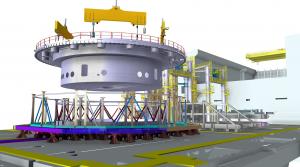All large machine components will transit through the ITER Assembly Hall—entering through double doors on the south end, pausing at a laydown area for preparation or pre-assembly, and ultimately traversing the length of the building on the cables of the overhead bridge cranes for installation inside the Tokamak pit.
"In the months and years ahead, some of the largest machine components will be going through the Assembly Hall," says Brian Macklin, who leads the Construction Department's Ex-Vessel Assembly Group. "Planning for the routing of a component through the Assembly Building is not just a matter of bringing it from point A to point B—we must also take into account other components arriving at the same time, the availability of the overhead cranes, space constraints in the Assembly Hall, and other activities inside the building."
Avoiding bottlenecks requires the integration of detailed schedule information for each work package—what is arriving when, and what preparation or pre-assembly activities must be carried out in the Assembly Hall—with 3D models of the relevant components, tooling and assembly spaces.
"4D scheduling is the result of merging 3D data with scheduling data," says Lynton Sutton, who is the contractor doing the 4D planning for Macklin's group through his company Brigantium Engineering. "Using 4D planning, we are able to optimize and validate the coordination planning of different work packages and the use of space; we have also used 4D to model different scenarios to aide in decision-making. 4D has been a vital tool for construction sequence visualization—enabling us to identify critical risks and clashes that may have been difficult to spot using traditional planning method alone. In addition, we are able to create video animations using 4D, which are valuable tools for communication."
Having accurate, up-to-date, configuration-controlled input is critical. Sutton has developed an internal process for accessing validated CAD models from the ITER Organization Design Office and associated schedule data from the workface planners of the
MOMENTUM consortium—the Construction Management-as-Agent responsible for the day-to-day planning of ITER assembly.
The group used 4D to model the recent
cryostat base installation operation (
click on the animation below), and is currently working on scenarios for the next large components to enter the Assembly Hall—the cryostat lower cylinder, the lower cryostat thermal shield, and vacuum vessel Sector #6.
"4D planning allows us to display complex sequences in a visual form that is immediately understandable by all," says Macklin. "It's hard to overstate how powerful this tool can be for avoiding clashes and rework, and for bringing all teams to the same understanding of a space allocation or sequencing problem, leading to faster resolution."
See the animation
here (courtesy of Lynton Sutton Engineering Ltd).


